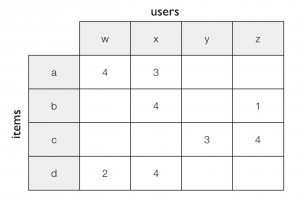theme: recommendation
theme: recommendation
Collaborative Filtering
2002

a sample collaborative filtering matrix.
(Seaver, 2012)The archetypal form of a collaborative filtering system is a matrix: a grid, with items along one side, users along the other, and ratings at their intersections. This matrix is mostly empty (or “sparse”), since most users will have not rated most items. The work of the collaborative filtering algorithm, as it typically stated, is to predict what values will show up in the empty spaces of the matrix. These predictions are then provided in some form to the user as recommendations. Thus, at any given time, the matrix is in an anticipatory flux: new ratings from users arrive constantly, displacing their predicted values and shifting the others. This filling process is the signature action within the matrix — blank values are replaced by predictions, which are then replaced by actual ratings. Progress from emptiness, through prediction, to actualization makes the matrix a proleptic social representation, holding simultaneously a record of past correspondences between persons and things and the anticipation of future ones.
(Seaver, 2012)theme: recommendation
theme: recommendation